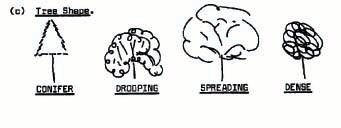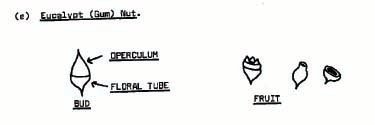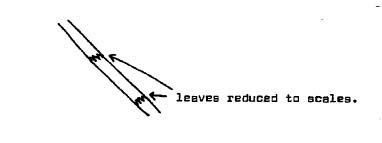DESCRIBING
TREES
Most
tree types have 2 names; a scientific (family) name and a common
name.
EXAMPLE
Kurrajong
is the common name for Brachychiton populneum. Scientific
names are in in italics. Common names are popular but confusing. Many
trees are called White gums but they are not all the same. The
scientifica name means there is only one name for that type or
species of tree and no other tree can have that name.
The
scientific name consists of 2 words. Eg white
box is eucalyptus albens.
- Eucalyptus is the genus
name and means that all trees called Eucalyptus are similar in many
ways.
- Albens means this tree
is different from the other Eucalypts.
A
number of characteristics are used to identify and describe trees.
These are as follows:
LEAF
ARRANGEMENT
LEAF
SHAPE
TREE
SHAPE
STALKING
EUCALYPT (GUM) NUT
BARK
OF EUCALYPTS
GUM
----> smooth to touch
BOX
-----> rough may be smooth on upper branches
IRONBARK
------> very rough, hard & corrugated
STRINGYBARK
-----> rough pulls off in long strips
BLOODWOOD
-------> rough with squareish pattern
BRACKS
SEGMENTS
OF THE NUTS OF CYPRESS PINE
TRICK
LEAVES
Not
all trees have true leaves. Some leaves are so small it is almost
impossible to see them. When this happens as with cypress
pine the stem takes over the work of the leaves and is called
a CLADODE.
In
some wattles the leaves have disappeared entirely to be replaced with
an enlarged leaf stalk called a PHYLLODE.
IDENTIFICATION
1.
TREES THAT LOOK LIKE EUCALYPTS (GUMS)?
YES
--> 2 NO --> G
- MATURE
LEAVES OPPOSITE & NUTS RIDGED?
YES
----> B
- MATURE
LEAVES ALTERNATE & NUTS SMOOTH?
YES---->
C
B.
ANGOPHORAS (NATIVE APPLES)
BARK
SMOOTH, SALMON PINK?
YES
---> smooth barked apple (angophora
costata)?
BARK
ROUGH & LEAVES USUALLY WIDER THAN 2CM?
YER--->
rough barked apple (angphora
floribunda)
- EUCALYPTS
BARK
MOSTLY SMOOTH. MAY BE ROUGH AT BASE OF TRUNK?
YES
-----> D
BARK
ROUGH ON TRUNK MAY BE SMOOTH ON UPPER BRANCHES
BARK
VERY HARD DARK & CORRUGATED?
YES
---> ironbark ----> E
NO
----->F
- GUMS
TREE
FOUND ON RIVER BANK OR FLOOD PLAIN?
LARGE
TREE ALWAYS FOUND ON FLOOD PLAIN?
YES---->river
red gum (e cameldulensis)
NO
---->LEAVES & BUDS ASHY. ROUGH BARK PARTWAY UP. TRUNK
YES--->RED
GUM USUALLY FOUND SHALLOW STONEY SOILS.
hill
red gum (e deelbata)
BARK
BLOTCHED BUT SMOOTH --> red gum
MORE
COMMON ON DEEP SANDY SOILS ---> blakelys red
gum
(e
blakelyi)
E.
IRONBARKS
LEAVES
BROAD & SILVERY, OPPOSITE & STALKLESS, RELATIVELY SHORT
TRUNK. AND SPREADING CROWN.
YES
---> silver leaved ironbark (e
melonophilia)
LEAVES
NARROW & ASHY COLOURED. GENERALLY SMALL TREE. LEAVES ALTERNATE.
FRUIT 6-12 MM.
YES---->
blue leaved ironbark (e fibross)
LEAVES
LONG & NARROW & DULL GREEN. ALTERNATE & STALKED. FRUITS
SMALL 4-5MM.
YES
----> narrow leaved ironbark (e
crebre)
F.
BOXES
1.
LEAVES SHINY & GREEN?
YES
---> LEAVES ROUNDED & BROAD?
YES
-- > bimble box (e populnea)
LEAVES
NARROW & LONG?
YES---->pilliga
box (e pilligaaneis)
- LEAVES
ASHY OR GREEN GREY – NOT SHINY?
YES---->SPREADING
TREE, ASHY LEAVES. FRUIT 6-15MM?
YES
----> white box (e olbena)
- LARGE
DROOPING TREE. FRUITS <6MM. MAY HAVE VERY LITTLE BARK ON TRUNK.
YES----->
yellow box (e melliadora)
G.
NON EUCALYPTS
- LEAVES
REDUCED TO SCALES OR PHYLLODES?
YES---->
PHYLLODES. SMALL FLOWERS IN BRIGHT CLUSTERS?
YES---->
wattles
LEAVES
REDUCED TO SCALE -----> H
DROOPING
SHRUB. ASHY PHYLLODES. 5-9MMLONG X 3-8MM WIDE.
PODS
FIST & WINGED – 1CM X 2-5CM LONG
YES--------->
myall (boree) (acacia penduka)
PHYLLODES
SILVER & CURVED, 10-20CM LONG
YES
--> brigalow (a harophyllie)
PHYLLODES
GREYISH. 2-5CM LONG X 2-9MM WIDE. THIN PODS SLIGHTLY CURVED. 2-5CM
LONG.
YES----->
yarrah (a homalophylia)
- TREES
WITH TRUE LEAVES
YES
----> I
9











